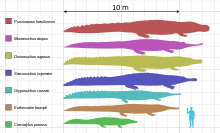- Mourasuchus
-
Mourasuchus
Temporal range: MioceneScientific classification Kingdom: Animalia Phylum: Chordata Class: Sauropsida Order: Crocodilia Suborder: Eusuchia Superfamily: Alligatoroidea Family: †Nettosuchidae
Langston, 1965Genus: †Mourasuchus
Price, 1964Species - M. amazonensis Price, 1964 (type)
- M. atopus Langston, 1966
- M. nativus Gasparini, 1985
Synonyms - Nettosuchus Langston, 1965
Mourasuchus is an extinct genus of giant crocodilian from the Miocene of South America. It was similar in length and weight to Rhamphosuchus. The skull has been described as duck like, being broad, flat and very elongate, closely resembling what is seen in Stomatosuchus, an unrelated crocodilian that may also have had a large gular sac similar to those of pelicans or baleen whales.[1] Mourasuchus had rows of small, conical teeth numbering around 40 on each side of the upper and lower jaws.[2] Mourasuchus presumably obtained its food by filter feeding; the jaws were too gracile for the animal to have captured larger prey. It also probed the bottoms of lakes and rivers for food. Fossils have been found in the Fitzcarrald Arch of Peru, where it coexisted with many other crocodilians, including the giant gharial, Gryposuchus, and the alligatorid Purussaurus, both of which were 12 m. The great diversity of crocodylomorphs in this Miocene-age (Tortonian stage, 8 million years ago) wetland suggests that niche partitioning was efficient, which would have limited interspecific competition.[3] Mourasuchus was 12 m (39 feet) long.
Species
The type species of Mourasuchus is M. amazonensis, named in 1964.[4] Another species, M. atopus, was named after having been initially assigned to its own genus, Nettosuchus, a year earlier in 1965.[5][6] The latter species has a longer and narrower skull than the type species. A third species, N. nativus, was named in 1985.[7]
References
- ^ Brochu, C. A. (1999). "Phylogenetics, Taxonomy, and Historical Biogeography of Alligatoroidea". Society of Vertebrate Paleontology Memoir 6: 9–100. doi:10.2307/3889340. http://jstor.org/stable/3889340.
- ^ Langston, W. (1966). "Mourasuchus Price, Nettosuchus Langston, and the family Nettosuchidae (Reptilia: Crocodilia)". Copeia 1966 (4): 882–885. doi:10.2307/1441424. http://jstor.org/stable/1441424.
- ^ Salas-Gismondi, R., Antoine, P. O., Baby, P., Brusset, S., Benammi, M., Espurt, N., de Franceschi, D., Pujos, F., Tejada, J. and Urbina, M. (2007). Middle Miocene crocodiles from the Fitzcarrald Arch, Amazonian Peru. In: Díaz-Martínez, E. and Rábano, I. (eds.), 4th European Meeting on the Palaeontology and Stratigraphy of Latin America Cuadernos del Museo Geominero, nº 8. Instituto Geológico y Minero de España, Madrid.
- ^ Price, L. I. (1964). "Sôbre o crânio de um grande crocodilídeo extinto do alto Rio Juruá, Estado do Acre". An. Acad. Brasileira Ciên 36 (1): 59–66.
- ^ Langston, W. (1965). Fossil crocodilians from Colombia and the Cenozoic history of the Crocodilia in South America. University of California Publications in Geological Sciences 52. University of California Press. pp. 1-152.
- ^ Langston, W. (1966). "Mourasuchus Price, Nettosuchus Langston, and the family Nettosuchidae (Reptilia: Crocodilia)". Copeia 1966 (4): 882–885. doi:10.2307/1441424. http://jstor.org/stable/1441424.
- ^ Gasparini, Z. B. (1985). "Un nuevo cocodrilo (Eusuchia) Cenozoico de América del Sur". Coletânea de Trabalhos Paleontológicos do IIX Congresso Brasileiro de Paleontologia, MME-DNPM 27: 51–53.
This article about a prehistoric archosaur is a stub. You can help Wikipedia by expanding it.

